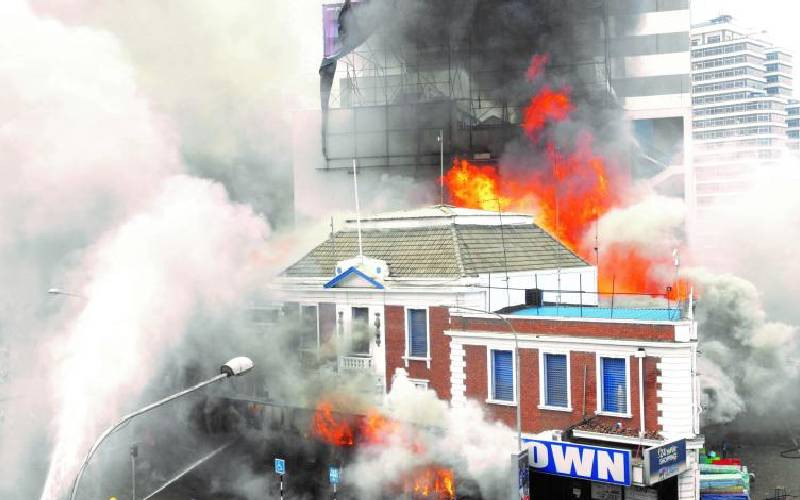By Lillian Aluanga
First there was Haiti, then Chile, Taiwan and Turkey, all struck by a string of earthquakes that have rattled the world in the past few months.
In Haiti, more than 200,000 people were killed by a magnitude 7.0 quake. Chile, with a quake much stronger than Haiti’s, registered fewer deaths at 1,000, largely attributed to its adherence to a strict building code. Just months before these quakes, others had shaken Indonesia, Tonga, Japan, Malawi and the US.
The quakes have rekindled memories of tremours that hit Nairobi, Central, Eastern, Rift Valley, and Coast provinces, following volcanic activity on Ol Donyo Lengai, a mountain near Lake Natron, Tanzania, in 2007.
At the time, concerns were raised over the possible damage to buildings and loss of life should a major quake hit the country. This followed reports that 50 per cent of buildings in Nairobi could not withstand a quake.
Three years later, little has changed, if the collapse of buildings in Kiambu, Kisii, and Nairobi, all attributed to poor workmanship, is anything to go by.
"If a quake similar to Haiti’s hit Nairobi, the damage would be unthinkable," says University of Nairobi’s Prof Nobert Opiyo.
"Many buildings would not withstand the impact because we have been putting up structures as if an earthquake could never occur in Kenya. We are building structures as though Nairobi were in a stable position, but it isn’t," he says.
Disaster unpreparedness
Opiyo, an associate professor at the Geology department, says had a quake similar to the one in Chile, at magnitude 8.8, struck Haiti, "the whole country would have been flattened".
"Chile and Japan know they are in earthquake zones and therefore ensure their buildings are structured to withstand this. We, too, are in an earthquake prone region, but the construction of many buildings does not reflect this," says Opiyo.
Besides a lack of public awareness on what to do during an earthquake, Opiyo, who also manages the International Monitoring Systems Unit at the geology department, says Kenya remains ill prepared to handle such a disaster.
"An earthquake of magnitude 6.0 could easily flatten buildings in several residential areas within the city and nearby towns," says Opiyo.
Regulations governing the construction of buildings in relation to possible earthquakes date back to the 1973 Code of Practice for the Design and Construction of buildings and other Structures in Relation to Earthquakes. This followed publication of Prof I S Loupekine’s report on earthquakes in Kenya. Currently, major segments of the Building Code have been in existence since 1967, but a draft of the new Planning and Building Code is yet to be presented to Cabinet.
The intensity and length of time of a structure’s movement due to the initial seismic shock is often related to the type of ground on which the foundations are built. For structures built on soft ground, an earthquake’s motion is likely to be amplified, which means vibrations will continue for some time after the initial shock wave.
According to the 1973 Code, building on deposits with high water content and on ground liable to subsidence, slipping or large settlements, should be avoided, since earthquake shocks are likely to set these in motion.
While advocating simple, uniform and compact configurations that are rectangular or square shaped, the Code discourages buildings of complicated asymmetrical designs such as U or E shapes, since such structures vibrate in a complicated way.
Chair of the Architects Chapter of the Architectural Association of Kenya, Waweru Gathecha, says buildings are designed in accordance with a whole range of standards including those on structural design.
"Kenya falls within an earthquake zone, for which there exists an Earthquake Design Code, which has existed since the early 1970s," he says.
The architect says each earthquake zone has clear design standards, based on its geographic location and likely seismic activity.
Development control
"Buildings in Kenya are, according to law, subjected to the process of development control, hence the process by which one makes an application to the local authority for clearance," he says.
Vice-Chairperson of the East and Southern Africa Region Seismological Working Group Gladys Kianji, cites the 1928 Subukia quake as the ‘most significant in Kenya’. The magnitude 6.8-quake is said to have rolled cars off the roads in Nairobi, about 200km away.
"Should a similar quake occur today, with the kind of buildings we have and population densities in our cities, the damage would be greater," says Kianji, a seismologist at the University of Nairobi.
So far, the highest event recorded in the Eastern African region is a 7.5 magnitude quake in Southern Sudan in 1990. Other large quakes on the continent have been in Mozambique (7.3), and Tanzania (6.3). Ethiopia, Zambia, Malawi and Uganda are also in the high-risk list.
According to the US Geological Survey, earthquake activities in the world led to 1,783 deaths last year, with the deadliest being a magnitude 7.5, which killed more than 1,000 people in Indonesia. The previous year recorded a much higher figure at 88,000, with China’s Sichuan Province having the highest number of casualties following a magnitude 7.9 temblor.
Gathecha says it is crucial for developers to seek services of a registered structural engineer for preparation of structural design drawings and calculations.
Worst manifestation
"They have been trained to understand and interpret the Earthquake Design Code and will take into consideration what is proposed," he says. Scrutiny of one’s development application — in the case of buildings — includes submission of architectural and structural drawings and calculations, submitted by a registered architect or engineer.
But the recent collapse of buildings, tells a different story.
According to the architect, the collapse of these buildings represent the ‘worst manifestation of the process of building design, and development control’, and that they perhaps, like many others never had a chance of withstanding a quake.
"About 50 per cent of the buildings in Nairobi are unapproved, but this doesn’t mean they are in imminent danger of collapse. It may mean that regularisation of their approval status is yet to be undertaken," he says.
The architect, however, says the other 50 per cent may not be necessarily safe from structural collapse due to earthquake damage.
So if a major quake were to hit the country, would our buildings pass the test? "Being granted permission to develop is not in its own right a guarantee that your building is structurally sound.
"It is the actual design and adherence to design specifications during construction that makes the difference between structural stability and collapse," says Gathecha.
 The Standard Group Plc is a multi-media organization with investments in media
platforms spanning newspaper print operations, television, radio broadcasting,
digital and online services. The Standard Group is recognized as a leading
multi-media house in Kenya with a key influence in matters of national and
international interest.
The Standard Group Plc is a multi-media organization with investments in media
platforms spanning newspaper print operations, television, radio broadcasting,
digital and online services. The Standard Group is recognized as a leading
multi-media house in Kenya with a key influence in matters of national and
international interest.
 The Standard Group Plc is a multi-media organization with investments in media
platforms spanning newspaper print operations, television, radio broadcasting,
digital and online services. The Standard Group is recognized as a leading
multi-media house in Kenya with a key influence in matters of national and
international interest.
The Standard Group Plc is a multi-media organization with investments in media
platforms spanning newspaper print operations, television, radio broadcasting,
digital and online services. The Standard Group is recognized as a leading
multi-media house in Kenya with a key influence in matters of national and
international interest.









